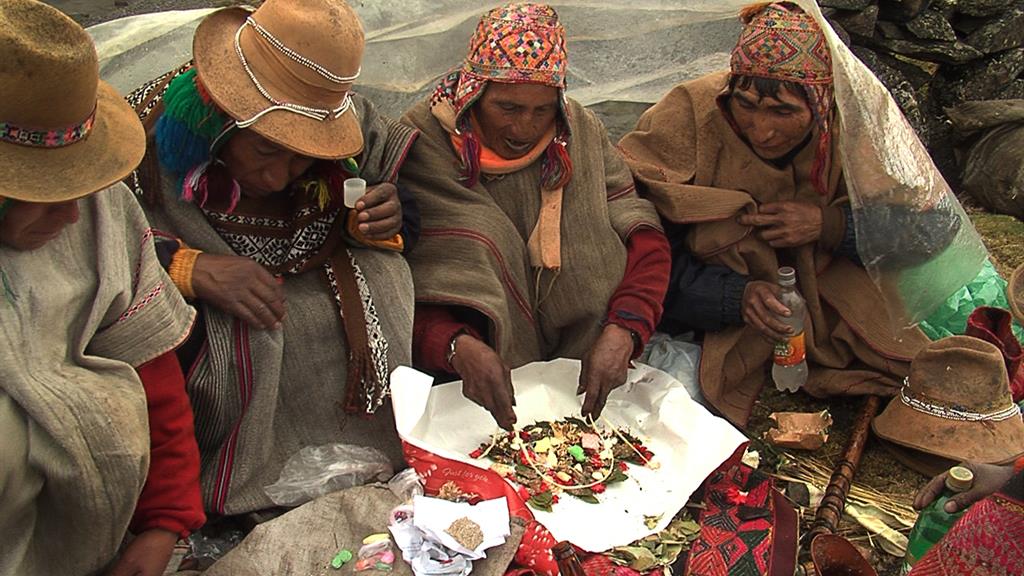Pavilion of Latin America-IILA (Italo-Latin American Institute) at the 56th International Art Exhibition – la Biennale di Venezia “VOCES INDÍGENAS”, when the voice is the soul of a people May 9th – November 22nd, 2015
José Quispe, Huachipaire ethnic group, in a ceremony invoking the tutelary deities, Peru
Photo: Jose Huaman

PRESS RELEASE
at the 56th International Art Exhibition – la Biennale di Venezia
“VOCES INDÍGENAS”, when the voice is the soul of a people
May 9th – November 22nd, 2015
Isolotto dell’Arsenale, Venice
Opening: Friday May 8th, 2015 at noon
IILA – Italo-Latin American Institute has been participating at the 56th International Art Exhibition – la Biennale di Venezia since 1972 with the own Pavilion dedicated to Latin America, carried out in collaboration with the Embassies of the Latin American members countries and Goethe Institut as institutional partner.
In the 2015 edition of the Pavilion, which will be opening on Friday, May 8th at noon, in the wide venue of Isolotto dell’Arsenale, IILA proposes a great sound installation realized thanks to the work of artists from the Latin American member countries.
Old languages are gathered in a sort of “Common House of the Art”, thanks to the artistic care of the Curator Alfons Hug and the Deputy Curator Alberto Saraiva, as well as the careful organization of the Commissioner Sylvia Irrazábal, Chief of IILA Cultural Department. In fact, they show a state of mind open to dialogue, encounter and comparison in cultural as well political, scientific and economic matters, based on mutual respect and valorization of cultural pluralism.
The topic chosen for this Biennale Arte 2015 is “Indigenous Voices”: it is extremely appealing and evokes a re-appropriation of the genetic-cultural heritage through listening to the deep roots, giving voice, space, freedom of expression. Never silent voices that want to be listened throughout the centuries, telling their story in order to testify the vitality of their customs, traditions, legends, magic and values sprung from the native earth, through a sound installation inclined towards the valorization of a plurality of languages of local communities and native ethnic groups.
The Pavilion of Latin American-IILA pretends to be the location of this listening, this sounding board that tells us about the natural rights, the bond with the earth from which we were born, the harmony between people, a sort of ancient never lost innocence. These topics were beloved by the great German explorer and naturalist Alexander von Humboldt, who told us about his famous parrot, thanks to which he could listen to sounds and phonetic articulations of the original Latin American linguistic treasure and of extinguished or on the verge of extinction ethnic groups.
Alfons Hug reminds us that the indigenous voices of Latin America are not dead. On the contrary, they are a living genetic-cultural treasure to be revalued. The polyphony of languages, that merge into a unique, refined and strong message, lands to Venice and proposes a new interpretation that proudly comes up to our attention and understanding.
In the Pavilion will be presented the following Latin American artists: Sofia Medici and Laura Kalauz (Argentina), Sonia Falcone and José Laura Yapita (Plurinational State of Bolivia), Adriana Barreto (Brazil), Paulo Nazareth (Brazil), Rainer Krause (Chile), León David Cobo, María Cristina Rincón and Claudia Rodríguez (Colombia), Priscilla Monge (Costa Rica), Fabiano Kueva (Ecuador), Mauricio Kabistan (El Salvador), Sandra Monterroso (Guatemala), Barbara Prézeau Stephenson (Haiti), Leonardo González (Honduras), Humberto Vélez (Panama), Raúl Quintanilla (Nicaragua), Erika Meza e Javier López (Paraguay), José Huamán Turpo (Peru), Gustavo Tabares (Uruguay), Ellen Slegers (as a special participation, German artist linked to Latin America).
TECHNICAL FORM
Voces indígenas (Indigenous voices)
Pavilion of Latin America-IILA (Italo-Latin American Institute)
56th International Art Exhibition – la Biennale di Venezia
Commissioner: Sylvia Irrazábal
Curator: Alfons Hug
Deputy Curator: Alberto Saraiva
Exhibition design: Paola Pisanelli Nero
May 9th – November 22th 2015
Isolotto, Arsenale – 30122 Venice
Friday May 8th, 2015
12.00 pm: Opening
12.00 pm: Delegated performance by Humberto Vélez (Panama) Miss Education, 2013 – 2015
Courtesy: the artist
For additional information
Cultural Department IILA
Ph: +39 0668492.225/246; e-mail: s.culturale@iila.org
Press Office IILA
Francesco Accolla: mobile: +39 349 2364924; ph (office): +39 0668492.223; e-mail: gf.accolla@iila.org
Esperanza Anzola: mobile: +39 340 7213593; ph (office): +39 06 68492.210; e-mail:stampa@iila.org
Loredana Riccardo: mobile + 39 338 5410521; ph (office): +39 06 68492.219; e-mail: l.riccardo@iila.org
|
Partner |
|
|
Main Sponsor |
|
|
Sponsor |
|
VOCES INDIGENAS
Pavilion of Latin America-IILA (Italo-Latin American Institute)
at the 56th International Art Exhibition – la Biennale di Venezia
Friday, May 8th, 2015 at 12.00 pm
Pavilion of Latin America-IILA, Isolotto dell’Arsenale
Humberto Vélez (Panama)
Miss Education, 2013 – 2015
Performance
Courtesy: the artist
For the first time in history, a beauty pageant and its candidates are performing actively in the creation of an artwork. Miss Education began as an artistic intervention in the “Miss Panama” contest, conceived specifically for Luis Camnitzer – renowned artist, pedagogue, and art critic – during the international forum titled “VISITING MINDS. Radical Pedagogy: Art as Education,” held in Panama City in May 2013.
With Miss Education, Humberto Vélez intended to confront artistic and intellectual prejudices by exploring elitist and common stereotypes of art, education, and beauty through the lens of mass media events and popular culture. Vélez wanted to challenge, in a playful (though not sarcastic) way, the concepts of art and education by mingling situations and attitudes of the sophisticated art world with a beauty pageant of great popular and media impact. For this purpose, Luis Camnitzer served as jury president of “Miss Panama” and personally chose a new “Miss” with the title of Miss Education.



